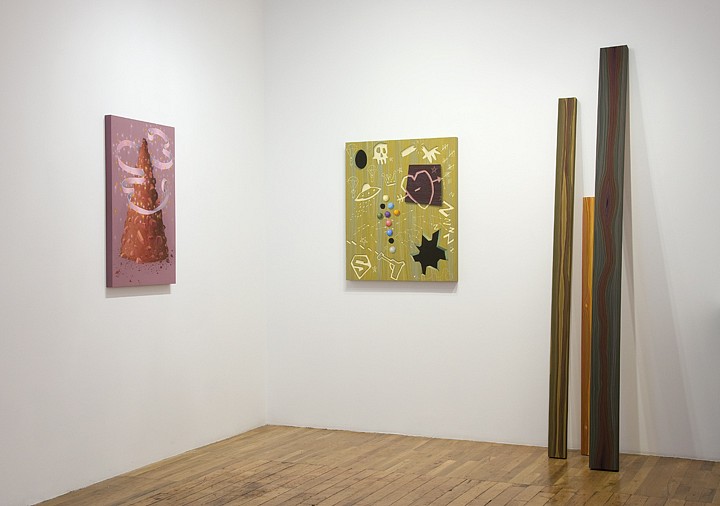PRESS RELEASE

Populated by magical auras and graffiti-filled surfaces, Steve DeFrank’s new series of paintings in Mirror, Mirror construct an idiosyncratic realm in which everything and nothing is taken seriously. Rendered in a caricatured naturalism that is intentionally reminiscent of mass media entertainment, the paintings are playful, but in a mischievous and subversive way. While projecting an air of frivolity, they function on a deeper level, delving into the mood of life’s experiences and confronting common perceptions regarding homosexuality.
Using wood, in both its natural and by-product forms, as the common pictorial thread in this body of work, DeFrank addresses these issues beneath a disarmingly innocent veneer. Tree stumps, with at times shocking phrases carved into their bark, are surrounded by the twinkling of enchanted lights and floating bubbles; while, others possess flowing manes of hair that in a surrealist twist take on a nearly human persona. Leaves, devoured to shreds by an absent pestilence, offer in their shredded forms unexpected messages that comment ironically on their fate. Roughly hewn boards, nailed together as if covering the window of an abandoned building, attest to the change that accompanies the passing of time by recording the assorted terms, both derogatory insults and insider code words, used to connote male homosexuality.
The formal beauty of the paintings – their velvety matte surfaces and rich colors – temporarily disguises the implications of the images. Silhouetted against monochrome backgrounds, the half-eaten leaves, the castrated trees, the piles of rubble - all episodes of destruction - are denied contextual specificity. Standing on their own without a narrative to ground them, these objects and the words inscribed on them are made even more equivocal by the artist’s vibrant color choices and his inclusion of fantasy, which imbues the paintings with lightheartedness. The incongruence of the juxtaposed elements ultimately highlights the artist’s message: this is a world much like Cinderella’s where despondency reigns but hope nevertheless persists.
DeFrank, who trained as a painter at the Maryland Institute College of Art and the School of Visual Arts in New York, has for the past ten years created multi-media constructions that employed the Lite-Brite pegs of our childhood. Envisioned first as paintings, the compositions were then translated by a computer software program the artist designed into pointillist arrangements, which were finally completed in three-dimensions using specially-dyed pegs.
Abandoning this process in order to explore a new vocabulary of expression, DeFrank now works in casein, an ancient medium that uses the protein complex in milk as the binding agent for the pigment. Difficult to apply and unforgiving, casein requires a meticulous execution, which is fully evident in these works. The end result is a flawless, textureless surface and incredibly vibrant hues. Despite the change in his technical approach, DeFrank has not limited himself to two dimensions. In conjunction with the paintings, he has created a series of “Stud” works, in which he paints a fictive wood grain pattern on actual boards. Named after gay male pornography stars, the Studs further the phallic aspect of the humorous and pun-filled fantasy world the artist has constructed.
DeFrank’s art is first and foremost his own private playground, a vehicle for exploring issues central to his personal identity. Thus, it comes as no surprise that this new series of paintings are a continuation of the themes present in the Lite-Brite works. In both cases, DeFrank relies heavily on forms inspired by mass culture. He grants these elements, often considered kitsch by the artistic hierarchy, validity by inserting them into fine art conceptions. Transforming the playful into the significant while making the all too serious humorous, the artist reveals his own approach to life. Resigned to the inevitable hurdles that arise, DeFrank and his paintings triumph through a resilient optimism and a persistent sense of humor.
A new addition to the roster of artists at Margaret Thatcher Projects, DeFrank is part of a recent expansion in the gallery’s program to include figurative work that is both rigorous in its technical approach and conceptually driven. DeFrank, who has also had solo exhibitions at Clementine Gallery and Clifford Smith Gallery in Boston, is represented in the permanent collections of the New Museum of Contemporary Art and the West Collection.
